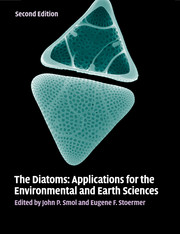Book contents
- Frontmatter
- Contents
- List of contributors
- Preface
- Part I Introduction
- Part II Diatoms as indicators of environmental change in flowing waters and lakes
- 4 Assessing environmental conditions in rivers and streams with diatoms
- 5 Diatoms as indicators of long-term environmental change in rivers, fluvial lakes, and impoundments
- 6 Diatoms as indicators of surface-water acidity
- 7 Diatoms as indicators of lake eutrophication
- 8 Diatoms as indicators of environmental change in shallow lakes
- 9 Diatoms as indicators of water-level change in freshwater lakes
- 10 Diatoms as indicators of hydrologic and climatic change in saline lakes
- 11 Diatoms in ancient lakes
- Part III Diatoms as indicators in Arctic, Antarctic, and alpine lacustrine environments
- Part IV Diatoms as indicators in marine and estuarine environments
- Part V Other applications
- Part VI Conclusions
- Glossary, acronyms, and abbreviations
- Index
- References
11 - Diatoms in ancient lakes
from Part II - Diatoms as indicators of environmental change in flowing waters and lakes
Published online by Cambridge University Press: 05 June 2012
- Frontmatter
- Contents
- List of contributors
- Preface
- Part I Introduction
- Part II Diatoms as indicators of environmental change in flowing waters and lakes
- 4 Assessing environmental conditions in rivers and streams with diatoms
- 5 Diatoms as indicators of long-term environmental change in rivers, fluvial lakes, and impoundments
- 6 Diatoms as indicators of surface-water acidity
- 7 Diatoms as indicators of lake eutrophication
- 8 Diatoms as indicators of environmental change in shallow lakes
- 9 Diatoms as indicators of water-level change in freshwater lakes
- 10 Diatoms as indicators of hydrologic and climatic change in saline lakes
- 11 Diatoms in ancient lakes
- Part III Diatoms as indicators in Arctic, Antarctic, and alpine lacustrine environments
- Part IV Diatoms as indicators in marine and estuarine environments
- Part V Other applications
- Part VI Conclusions
- Glossary, acronyms, and abbreviations
- Index
- References
Summary
Introduction
We define ancient lakes as those that contain sedimentary records that span timescales since at least the last interglacial (c. 128 ka before present (BP)). We use this definition because by far the majority of diatom applications and reconstructions are undertaken on lakes that have formed since the end of the last glaciation (Termination 1). Ancient lakes are commonly found within grabens in active rift zones. Important examples include lakes Baikal (Russia), Biwa (Japan), Hövsgöl (Mongolia), Kivu (Democratic Republic of Congo, Rwanda), Malawi (Malawi, Mozambique, Tanzania), Ohrid (Albania and Macedonia) and Prespa (Greece, Albania and Macedonia), Tanganyika (Burundi, Congo, Tanzania), Titicaca (Bolivia, Peru), Tule (USA), and Victoria (Kenya, Tanzania, Uganda). These extant lakes contain sedimentary archives that often span at least the full Quaternary period (c. 2.6 million years (Ma)). Other ancient lakes with significantly long sedimentary archives include those associated with volcanic activity, e.g. Lake Albano (Italy), karst landscapes, e.g. Ioannina (Greece), and meteorite-impact craters such as El'gygytgyn (Russia), Pingualuit (Canada), Bosumtwi (Ghana), and Tswaing (formerly known as the Pretoria Salt Pan) (South Africa).
Diatom records from ancient lakes provide potentially powerful insights into mechanisms of environmental change over glacial–interglacial (G–IG) timescales, with most studies focusing on interpretation of paleoclimate records. However, records from ancient lakes can also provide useful insights into ecology and evolution of diatoms over long timescales (Khursevich et al. 2001).
- Type
- Chapter
- Information
- The DiatomsApplications for the Environmental and Earth Sciences, pp. 209 - 228Publisher: Cambridge University PressPrint publication year: 2010
References
- 9
- Cited by



